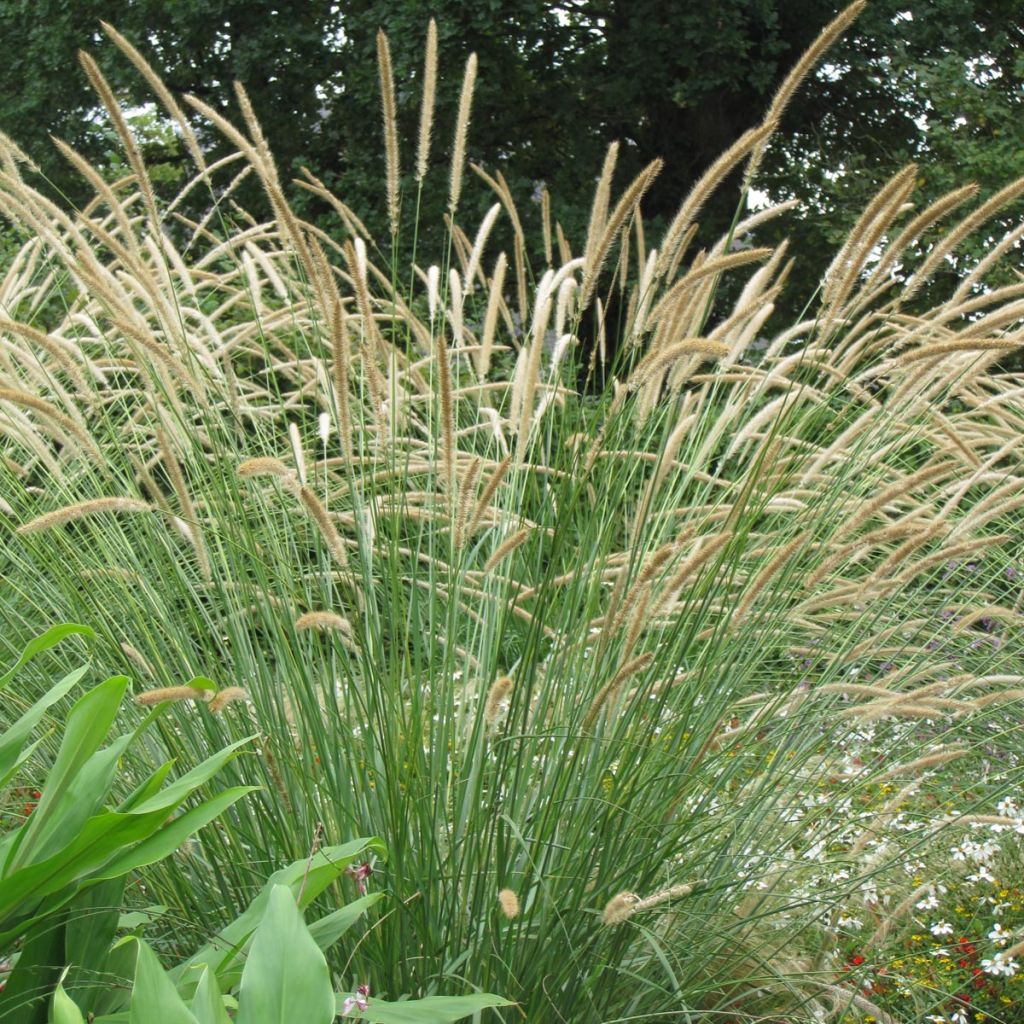

Pennisetum macrourum - African feather Grass
Pennisetum macrourum - African feather Grass
Pennisetum macrourum
African feather Grass
Excellent recovery for this entire order (Pennisetum macrourum, Collection 3 Gauras in Pink and White, Stipa arundinacea, Santolina chamaecyparissus, Sedum chocolate cherry). A big thank you for your care sheets that allowed me to make the bold choice of planting all this directly in the gravel of my courtyard. I hope everything will continue to thrive without self-seeding too much!
Komoku, 21/09/2025
Special offer!
Receive a €20 voucher for any order over €90 (excluding delivery costs, credit notes, and plastic-free options)!
1- Add your favorite plants to your cart.
2- Once you have reached €90, confirm your order (you can even choose the delivery date!).
3- As soon as your order is shipped, you will receive an email containing your voucher code, valid for 3 months (90 days).
Your voucher is unique and can only be used once, for any order with a minimum value of €20, excluding delivery costs.
Can be combined with other current offers, non-divisible and non-refundable.
Home or relay delivery (depending on size and destination)
Schedule delivery date,
and select date in basket
This plant carries a 12 months recovery warranty
More information
We guarantee the quality of our plants for a full growing cycle, and will replace at our expense any plant that fails to recover under normal climatic and planting conditions.

Would this plant suit my garden?
Set up your Plantfit profile →
Description
Pennisetum macrourum is a large, stunning grass with a delicate and slim texture. It blooms in abundance during late summer at the same height as a human, with long, cotton-like spikes that are initially white but turn beige over time. This African "fluffy grass" is not the hardiest of plants but remains among the most graceful and decorative. Its foliage can withstand mild winter climates.
The Pennisetum macrourum is a plant species that belongs to the Poaceae family. It is native to southern Africa, tropical Africa, and Yemen and does not tolerate temperatures below -10 °C. This perennial and rhizomatous grass has rapid growth after establishment and has an upright and narrow habit. At maturity, it forms a clump of about 1.80 m in height in flowers. It is known for its long, thin leaves, which measure 50 to 60 cm (23.6 in), are linear and persistent in warm regions, and have a relatively bright medium green colour. The flowering season usually starts in early August. Many slightly arched stubbles emerge from the foliage, bearing a cotton-like cylindrical inflorescence at their tip in the form of a fluffy spike 20 cm long. Their colour changes from white to beige and remains decorative for a long time. The rhizome fragments of this Pennisetum can regenerate a new plant if the conditions are met. It is considered invasive in New Zealand and certain regions of the U.S.A.
Pennisetum macrourum thrives in warm climates. It can be grown annually or kept in a pot to overwinter in a cold greenhouse in colder regions. This grass prefers sunlight and well-drained soil, even slightly dry. It is an excellent addition to large flower pots summer and autumn flower beds, and pairs well with large perennials like Asters or Echinaceas. The spikelets of Pennisetum macrourum are stunning in dried or fresh bouquets, especially when paired with dahlias.
Please note that our young plants in mini-pots are professional products intended for experienced gardeners. Upon receipt, we recommend repotting them and storing them under cover, such as in a conservatory, greenhouse, or cold frame, at a temperature above 14°C for a few weeks. This will help them acclimate before being planted outdoors once the risk of frost has completely passed.
Report an error about the product description
Pennisetum macrourum - African feather Grass in pictures




Flowering
Foliage
Plant habit
Botanical data
Pennisetum
macrourum
Poaceae
African feather Grass
South Africa
Other Pennisetum
View all →Planting and care
Pennisetum macrourum thrives best in a location with full sunlight during either spring or early autumn. It is essential to ensure that the plant is not planted too deeply and is grown in light, sandy, and well-drained soil, preferably with a limestone base. Once established, it becomes quite drought-resistant. However, it does not tolerate heavy and wet soils during winter, which may affect its hardiness. To protect the roots, it is necessary to apply ground mulch during harsh winters. In March, it is recommended to cut back the dry leaves. The plant can be propagated by dividing the clumps in spring.
Planting period
Intended location
Care
-
, onOrder confirmed
Reply from on Promesse de fleurs
Similar products
Haven't found what you were looking for?
Hardiness is the lowest winter temperature a plant can endure without suffering serious damage or even dying. However, hardiness is affected by location (a sheltered area, such as a patio), protection (winter cover) and soil type (hardiness is improved by well-drained soil).

Photo Sharing Terms & Conditions
In order to encourage gardeners to interact and share their experiences, Promesse de fleurs offers various media enabling content to be uploaded onto its Site - in particular via the ‘Photo sharing’ module.
The User agrees to refrain from:
- Posting any content that is illegal, prejudicial, insulting, racist, inciteful to hatred, revisionist, contrary to public decency, that infringes on privacy or on the privacy rights of third parties, in particular the publicity rights of persons and goods, intellectual property rights, or the right to privacy.
- Submitting content on behalf of a third party;
- Impersonate the identity of a third party and/or publish any personal information about a third party;
In general, the User undertakes to refrain from any unethical behaviour.
All Content (in particular text, comments, files, images, photos, videos, creative works, etc.), which may be subject to property or intellectual property rights, image or other private rights, shall remain the property of the User, subject to the limited rights granted by the terms of the licence granted by Promesse de fleurs as stated below. Users are at liberty to publish or not to publish such Content on the Site, notably via the ‘Photo Sharing’ facility, and accept that this Content shall be made public and freely accessible, notably on the Internet.
Users further acknowledge, undertake to have ,and guarantee that they hold all necessary rights and permissions to publish such material on the Site, in particular with regard to the legislation in force pertaining to any privacy, property, intellectual property, image, or contractual rights, or rights of any other nature. By publishing such Content on the Site, Users acknowledge accepting full liability as publishers of the Content within the meaning of the law, and grant Promesse de fleurs, free of charge, an inclusive, worldwide licence for the said Content for the entire duration of its publication, including all reproduction, representation, up/downloading, displaying, performing, transmission, and storage rights.
Users also grant permission for their name to be linked to the Content and accept that this link may not always be made available.
By engaging in posting material, Users consent to their Content becoming automatically accessible on the Internet, in particular on other sites and/or blogs and/or web pages of the Promesse de fleurs site, including in particular social pages and the Promesse de fleurs catalogue.
Users may secure the removal of entrusted content free of charge by issuing a simple request via our contact form.
The flowering period indicated on our website applies to countries and regions located in USDA zone 8 (France, the United Kingdom, Ireland, the Netherlands, etc.)
It will vary according to where you live:
- In zones 9 to 10 (Italy, Spain, Greece, etc.), flowering will occur about 2 to 4 weeks earlier.
- In zones 6 to 7 (Germany, Poland, Slovenia, and lower mountainous regions), flowering will be delayed by 2 to 3 weeks.
- In zone 5 (Central Europe, Scandinavia), blooming will be delayed by 3 to 5 weeks.
In temperate climates, pruning of spring-flowering shrubs (forsythia, spireas, etc.) should be done just after flowering.
Pruning of summer-flowering shrubs (Indian Lilac, Perovskia, etc.) can be done in winter or spring.
In cold regions as well as with frost-sensitive plants, avoid pruning too early when severe frosts may still occur.
The planting period indicated on our website applies to countries and regions located in USDA zone 8 (France, United Kingdom, Ireland, Netherlands).
It will vary according to where you live:
- In Mediterranean zones (Marseille, Madrid, Milan, etc.), autumn and winter are the best planting periods.
- In continental zones (Strasbourg, Munich, Vienna, etc.), delay planting by 2 to 3 weeks in spring and bring it forward by 2 to 4 weeks in autumn.
- In mountainous regions (the Alps, Pyrenees, Carpathians, etc.), it is best to plant in late spring (May-June) or late summer (August-September).
The harvesting period indicated on our website applies to countries and regions in USDA zone 8 (France, England, Ireland, the Netherlands).
In colder areas (Scandinavia, Poland, Austria...) fruit and vegetable harvests are likely to be delayed by 3-4 weeks.
In warmer areas (Italy, Spain, Greece, etc.), harvesting will probably take place earlier, depending on weather conditions.
The sowing periods indicated on our website apply to countries and regions within USDA Zone 8 (France, UK, Ireland, Netherlands).
In colder areas (Scandinavia, Poland, Austria...), delay any outdoor sowing by 3-4 weeks, or sow under glass.
In warmer climes (Italy, Spain, Greece, etc.), bring outdoor sowing forward by a few weeks.



















































